Do you know what the hourly rates are for software developers?
There are many factors that determine a software developer’s hourly rate: experience, skill level, dependability, etc., even the type of business the developer works for.
Whether you want to become a software engineer freelancer, find a better paying job, or need to hire a developer, it’s important that you be aware of these factors, as they form the basis for developers’ hourly rates.
What Determines a Developer’s Hourly Rate?
A software developer’s rate is influenced by many different factors, from their geographical location to their experience and customer feedback. Companies take these factors into consideration when they’re deciding who to hire, and freelancers consider them when they set their rates.
Geographical Location
The map below shows the difference in rates by country.

According to Eastern Peak, developers from offshore countries like Poland, Ukraine, or South Africa have the lowest hourly rates. Next is nearshore South America, and the most expensive developers are from the US.
Business Type
Whether a developer works as a freelancer or an employee affects their hourly rates. A freelancer has to cover all their own expenses and overhead, such as their equipment, office costs, and insurance. A company pays for things like health insurance and paid time off in their hourly rate consideration. So it’s natural that companies’ hourly rates are higher than freelancers’.
Speaking about companies, they can be divided into several types:
- Enterprise-Class Companies (Microsoft, Dell, Symantec) – These are large companies with several hundred to several thousand developers, not to mention the other employees. The salaries are usually the biggest on the market. These are the “dream jobs” for every developer, especially in the beginning of their career.
- Business-Class Companies (Rightpoint, WillowTree) – These companies are smaller, often from 100 to 1000 workers. Their hourly rates, according to data from Clutch, is also lower—from $150 to $300. The starting price for their projects is usually around $125,000 but can go up to $5,000,000.
- Midmarket Companies (The Software House, thoughtbot) – These companies usually have no more than 100 employees. Like most midmarket businesses, they offer an excellent balance between price and quality, and so their employees usually make an average of $50 per hour. They can work both with small and medium-sized businesses or projects, as well as with large corporations.
- Small-Market Companies (Urban Insight, Unleashed Technologies) – Companies of this class have up to 50 employees, and just a few projects a year allows them to stay afloat. Usually, they focus on one functional task: on the mobile applications or UI / UX design, or on one specific programming language. Typically, such companies work with small businesses or local companies.
- Offshore and Nearshore Companies – Offshore (Central and Eastern Europe) companies have the lowest hourly rates: $25 to $50. Nearshore companies are a bit more expensive, with rates from $40 to $75 per hour. Working with these companies has its risks, but for new developers, they could be a good way to build a portfolio. Time zone differences or language barriers can make these companies harder to work with, but most offshore companies will try to organize the workflow for easier tracking by customers and employees.
Development Experience
How do freelance software developers determine the rate for their services? Basically, there are two types of freelancers: raw and crusty.
Jokes aside, two main types of freelancers are:
- Newbies who recently finished their studies and are ready to test themselves
- Professionals who are simply tired of working a 9-5 job
For newbies, it is better not to ask for high hourly rates because this will scare off your clients. Most often, it’s a good idea for new freelancers to allow the customer to set the price for their project. New developers are excited, inspired, and want to get started working as soon as possible, but they don’t have a track record that potential employers or clients can use to judge their past work.
Because beginners are still learning, the customer will not want to pay top dollar in case the developer makes a mistake or isn’t able to deliver on time. It’s the same in any field—you have to put in the time before you start making more money. So, newbies’ hourly rates will usually not exceed $15-25.
A professional software development freelancer has lived in the IT world long enough to know what to reckon on. They will not be too excited about new projects but may demand higher hourly rates based on their experience and likely knowledge of more than one programming language. They can behave like a famous detective and take on only those projects that seem interesting. Their hourly rates in the USA and Western Europe will vary from $45 to $100.
Payoneer has gathered hourly-rate data about freelancers in 2020 from all areas of development projects, and the rates for different IT solutions start at $20. Also, it counts each and every freelancer, from a beginner to a pro.

Do Clients Prefer Freelancers or Development Companies?
We looked at the different types of companies and freelancers, so maybe it's time to look at the benefits for the customer when working with one or the other.
Benefits of Hiring a Freelancer
Their main advantage for the client when working with a freelancer is that the freelancer wants the project more than the customer wants their work because of the competition. Let’s take a closer look at the other parameters:
- Price – As I mentioned earlier, hiring a freelancer to do the job will be cheaper than transferring the project to most companies (except for offshore). On average, freelancer hourly rates are around $60. Many clients turn to freelancers when they don’t have enough money to hire a full-time employee.
- Speed and flexibility – A freelancer is not tied to a Mon-Fri, nine to five schedule; they can work more (or less) than eight hours a day. The freelancer has more freedom than the office worker—they can choose their own project and work on it as quickly as they want. Since freelancers can set their working hours and get paid according to their own speed, projects can be completed faster.
- Self-education – Freelancing is a business. To draw the attention of customers, a freelancer will have to constantly educate themself and do everything possible to stand out from the competition. Therefore, most freelancers are constantly evolving and so, improving projects they’re working on.
- Many options – In the U.S. alone, there are almost 58 million developers who prefer to freelance. The client can choose a developer according to their experience and hourly rates.
Working with freelancers has and always will have cons. They will not give you a code warranty, and there is always the risk that the freelancer won’t be available to make changes to the project after it is completed.
Benefits of Hiring a Company
Now you know the pros of working with a freelancer. But what are the upsides to working with a company?
- Reliability and support – Many companies have IT consulting, and some even provide a warranty on the code, thus confirming its quality. In addition, the development company manages the project so that the client has less to worry about. The client gets more out of it, and so the bill will be larger.
- Control – Yes, the client is bound by the eight-hour work day, but at the same time, they are able to control the work on the project by checking it at every stage and personally visiting or contacting developers. In addition, the client has a guarantee that the developer will not disappear in the middle of the project. Development companies try to maintain constant communication with the customer, and some offshore companies like the MassMedia Group launch streams from the office to show that physical boundaries are not an obstacle for them.
- Transparent pricing – Companies provide the total price for their services with a step-by-step plan of action, including the hours allotted for each stage of development. The client knows what their funds are to be spent on and what features they will receive.Therefore, the risk of spending more than expected is minimal. Freelancers often cannot offer such a guarantee; that’s why they have cheaper rates.
- Many options – Though freelancers have the same advantage, the IT market is constantly expanding. Therefore, clients can choose the company that they like and at the rate they want to pay. If the top priority is to save money, they should consider an offshore company.
Which Is the Better Option?

We always see the bright side of what we don’t have; if you’re a freelancer, sometimes you’ll get tired of managing everything by yourself, and if you’re a full-timer, you might dream of more freedom.
Your outcome as either a freelancer or an employee will be affected by your experience and skill, so work hard on yourself, and make clients value your work.
It doesn’t matter if your priority is high hourly rates or being able to work slowly and quietly—your comfort is what matters. I hope that everything you learned here will be useful to you in your journey as a software developer!
